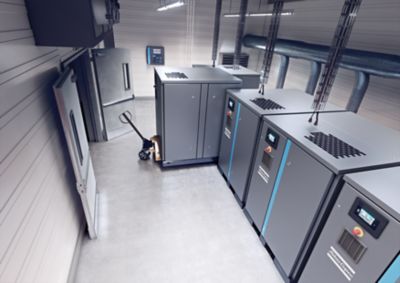Estimated reading time: 2 minutes
February 4, 2021
Did you know a single quarter-inch air leak at 100 psi can cost as much as $8,000 a year in lost compressed air? In older compressed air systems, up to 20% of the compressed air consumption may be lost through leaks. With today’s energy costs, taking the time to identify and plug leaks can save a facility money, energy and resources in the short term and can prevent larger problems from developing in the long term.
Identify Air Leaks
Even the smallest of compressed air system leaks can be a big drain on resources. Where there are leaks in the piping, there are also pressure drops, which force the compressed air system to work harder and use more energy. Eliminating pressure drops throughout the compressed air system has a domino effect that can result in significant and ongoing cost savings.
Try this: Compressed air audits can help a facility identify areas of improvement within the compressed air system infrastructure. There are three types of audits that can help identify leaks in the system. Learn more by reading this blog post: What are the differences between the three basic types of audits in terms of cost and benefit?
Prevent New Air Leaks
Once leaks have been identified and fixed, it’s important to take steps to prevent new leaks from forming. Dust and moisture in the pipes can lead to new leaks that compromise the system’s efficiency.
Try this: Ongoing and systematic maintenance of the entire compressed air system is the most effective way to prevent new leaks from forming. Be sure to check, clean or replace filters throughout the compressed air system. Filter maintenance goes a long way in decreasing pressure drops and increasing energy efficiency.
Ultrasonic leak detection
Compressed air leaks can easily become a significant source of wasted energy in an industrial facility, sometimes wasting 20 to 30 percent of a compressor’s output. But if you can’t see leaks, how do you detect them? Most experts agree that the use of an ultrasonic acoustic detector is the best way to detect leaks. This device recognizes the high frequency hissing sounds associated with air leaks and uses a variety of visual and audio indicators to identify the leaks’ location.
Ultrasonic leak detection is one of the most versatile forms of leak detection due to its ability to adapt to a variety of leak detection situations. Its acoustic sensor focuses in on fluctuations in noise to identify where mid- to large-sized leaks are located. Because ultrasounds are short wave signals and directional in transmission, they can identify leak sites by honing in on the loudest sound level. Ultrasonic detectors are generally unaffected by backgrounded noises in the audible range because the signals are filtered out.
How to fix leaks
- Leaks occur most often at joints and connections. Stopping leaks can be as simple as tightening a connection or as complex as replacing faulty equipment such as couplings, fittings, pipe sections, hoses, drains and traps.
- In many cases, leaks are caused by bad or improperly applied thread sealant, which can be fixed by properly installing equipment with the appropriate thread sealant.
- Another source of leaks can come from non-operating equipment. Equipment that’s no longer in use should be isolated with a valve in the distribution system.
- Lowering the demand air pressure of the compressed air system can also reduce leaks. The lower the pressure differential across an orifice or leak, the lower the rate of flow, which equals a decreased leakage rate.
Are you interested in establishing a leak prevention program that can save your industrial facility costly repairs?
Download our free Compressed Air Manual
- Compressed air manual 9th edition 11.4 MB, PDF

